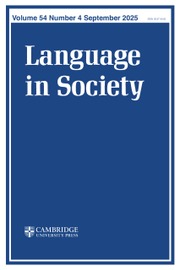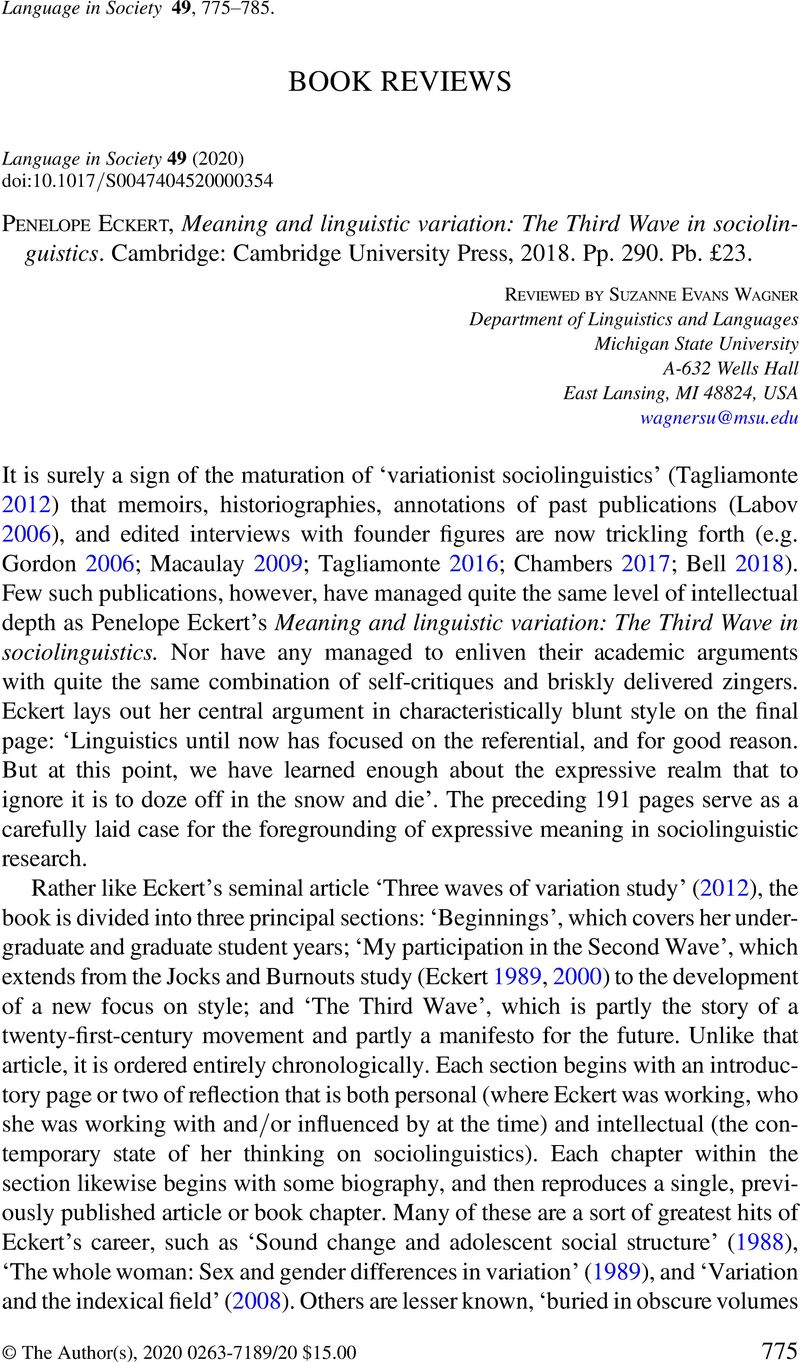It is surely a sign of the maturation of ‘variationist sociolinguistics’ (Tagliamonte Reference Tagliamonte2012) that memoirs, historiographies, annotations of past publications (Labov Reference Labov2006), and edited interviews with founder figures are now trickling forth (e.g. Gordon Reference Gordon2006; Macaulay Reference Macaulay2009; Tagliamonte Reference Tagliamonte2016; Chambers Reference Chambers2017; Bell Reference Bell2018). Few such publications, however, have managed quite the same level of intellectual depth as Penelope Eckert's Meaning and linguistic variation: The Third Wave in sociolinguistics. Nor have any managed to enliven their academic arguments with quite the same combination of self-critiques and briskly delivered zingers. Eckert lays out her central argument in characteristically blunt style on the final page: ‘Linguistics until now has focused on the referential, and for good reason. But at this point, we have learned enough about the expressive realm that to ignore it is to doze off in the snow and die’. The preceding 191 pages serve as a carefully laid case for the foregrounding of expressive meaning in sociolinguistic research.
Rather like Eckert's seminal article ‘Three waves of variation study’ (Reference Eckert2012), the book is divided into three principal sections: ‘Beginnings’, which covers her undergraduate and graduate student years; ‘My participation in the Second Wave’, which extends from the Jocks and Burnouts study (Eckert Reference Eckert1989, Reference Eckert2000) to the development of a new focus on style; and ‘The Third Wave’, which is partly the story of a twenty-first-century movement and partly a manifesto for the future. Unlike that article, it is ordered entirely chronologically. Each section begins with an introductory page or two of reflection that is both personal (where Eckert was working, who she was working with and/or influenced by at the time) and intellectual (the contemporary state of her thinking on sociolinguistics). Each chapter within the section likewise begins with some biography, and then reproduces a single, previously published article or book chapter. Many of these are a sort of greatest hits of Eckert's career, such as ‘Sound change and adolescent social structure’ (Reference Eckert1988), ‘The whole woman: Sex and gender differences in variation’ (Reference Eckert1989), and ‘Variation and the indexical field’ (Reference Eckert2008). Others are lesser known, ‘buried in obscure volumes because I've never had a particularly effective publication strategy.’ (xii). The volume is thus a kind of self-assembled festschrift.
As such, readers looking for an introduction to Eckert's work could do much worse than to purchase Meaning and linguistic variation. But what does it have to offer those of us who are already familiar with Eckert's oeuvre? I myself had read eight of the included twelve publications before. The answer is: Plenty. For one thing, there is a real difference between reading a paper in isolation, versus (re)reading it in chronological context, side-by-side with its sisters. Even without Eckert's opening and occasional closing remarks in each chapter, it would be possible to clearly trace the line from her early dialectological and historical work on Gascon to her most recent work on style, meaning, and affect. Laid out one after the other in this way, one can see that Eckert was preoccupied with individual and local perspectives on language variation from the beginning. It took time—and the adoption of the techniques and terminology of linguistic anthropology—for her to develop her own unique framework, which by the mid 2000s she was calling the ‘Third Wave’. But going beyond this, we have the added value of Eckert's notes illuminating the personal connections and milestones that made her journey to the Third Wave possible, and which serve as an interpretive lens on her thinking at every stage. Notable for introducing the term bricolage (Lévi-Strauss Reference Lévi-Strauss1966) to mainstream sociolinguistics, Eckert here lays out her own long process of intellectual bricolage. We see how she has selected inspirations from her mentors, collaborators, students, and even antagonists, and in doing so, assembled an approach to understanding language variation and change that is much more than the sum of its parts.
Yet what I found especially refreshing about Eckert's personal commentaries was the degree to which they deliberately underscore the happenstance of her career, and concomitantly the serendipity of her intellectual advances. Too few senior figures in academia are willing to publicly recognize the debt they owe to others, or to acknowledge the missteps they have made. In contrast, Eckert is sometimes searingly self-effacing (viz. the comment above about never having had a publication strategy). She is also not afraid to show how the world sometimes sent her down unexpected paths, or influenced her own view of herself as a researcher. There are some truly intimate moments in these memoir sections: The substitute high school French teacher who committed suicide after unknowingly inspiring Eckert to become a linguist; the mother and father stymied by gender barriers; Eckert's hidden but profound imposter syndrome. The cumulative effect is refreshing and inspiring. That said, there will be some readers who may find Eckert's voice overly intrusive or colloquial; others will value its authenticity.
Two particular highlights of Meaning and linguistic variation are chapters 1 and 2, which collectively cover the years of fieldwork in southern France, and chapter 11, titled ‘The semiotic landscape’. The France chapters throw light on Eckert's early development in the 1970s as a dialectologist and historical linguist, and subsequently a language activist. They provide a contrast, stylistically, with almost all of the following chapters, in which Eckert is drawn more and more to linguistic anthropology. In terms of content, too, the Gascon research will be novel to many readers, in part because it has been so overshadowed by the 1980s Jocks and Burnouts study. Chapter 11 also covers some new ground, but in a recognizably Eckert way. She has already led the way, over the years, in showing (variationist) sociolinguists how they can profitably apply extradisciplinary concepts like indexical order, enregisterment, recursion, iconicity, persona, and so on to the study of language variation and change. Here she unpacks some additional terms: construal, stylistic landscape, circulation, continuum of interiority. Eckert's intent here is to use these metaphors in order to challenge us to problematize our assumptions. This sometimes takes the form of rhetorical questions. For example, if children acquire linguistic variation early, why wouldn't they also engage with social meaning early? Self-evidently children don't reproduce the indexical fields and social personae of their parents’ generation (‘Most Yoga Moms did not have mothers who were Yoga Moms’, p. 190). Why do linguists conceptualize diffusion and incrementation as ‘spread’, when ‘circulation’ would better capture the nonlinearity of sociolinguistic variants’ pathway through time and space? (188). Why do we think of stylistic practice as reflecting a particular moment in a particular community, when the performance of style is undoubtedly also effecting social change? (189). And, a thought experiment: Why do people use sociolinguistic variables at all? Why don't people just straight up say, ‘I'm cool’ or ‘I'm educated’? (192).
This final question paves the way for Eckert's concluding case for the need for linguists—not just sociolinguists—to engage seriously with the ‘expressive realm’, lest we otherwise ‘doze off in the snow’. Speakers, she says, employ sociolinguistic variants precisely because variants are free to be ‘purely indexical’ and nonreferential (192). Eckert reserves her closing paragraphs for a summary of work by the colleagues and students who have developed a semantics of social meaning (e.g. Chris Potts, Eric Acton, Andrea Beltrama). Where this new avenue of intellectual inquiry will lead remains to be seen, but it's clear that Eckert has opened the door to it.



